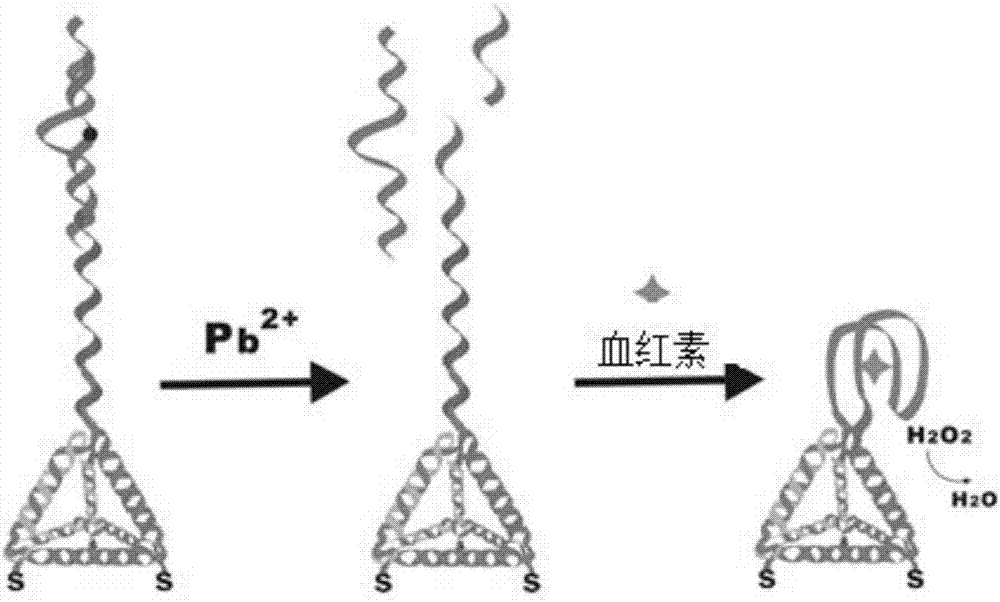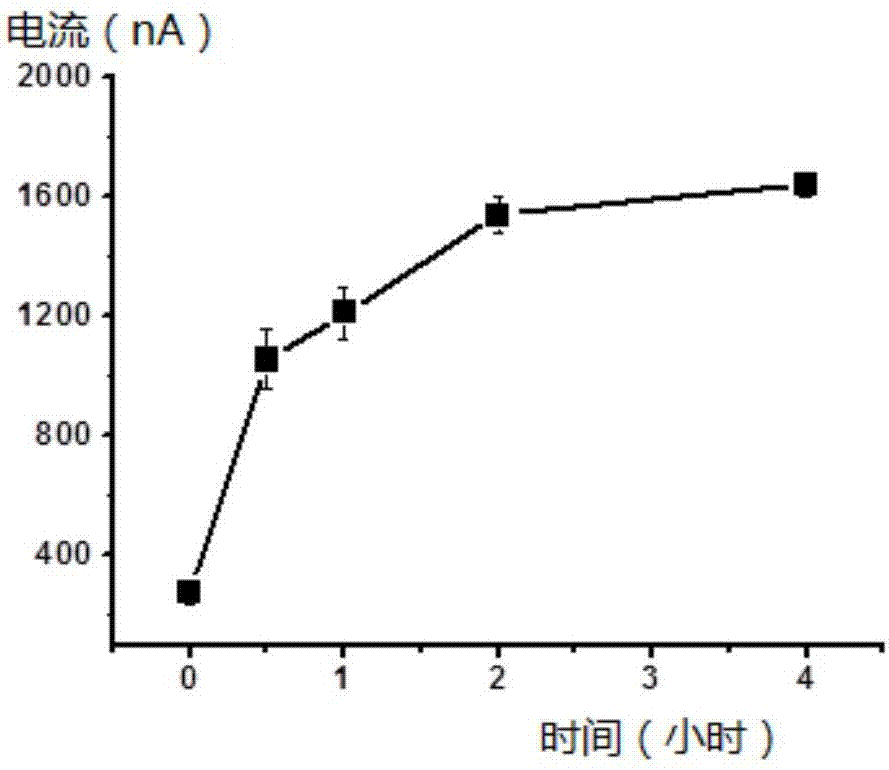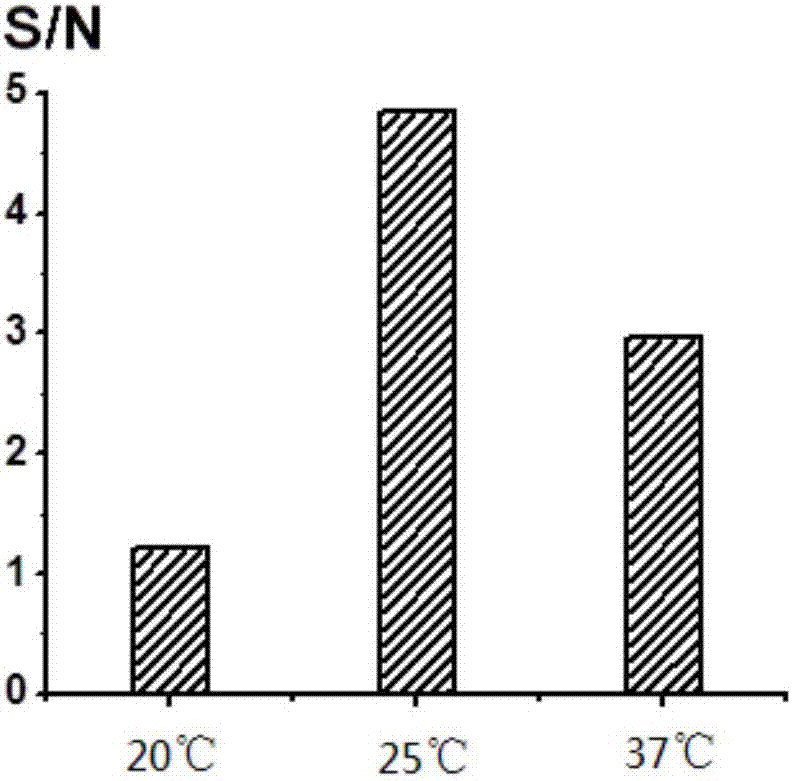DNA tetrahedron probe for lead ion detection, and lead ion detection method
A tetrahedral probe and lead ion technology, applied in the field of electrochemical detection, can solve the problems of lack of sensitive, simple, accurate and rapid detection of lead ions
- Summary
- Abstract
- Description
- Claims
- Application Information
AI Technical Summary
Problems solved by technology
Method used
Image
Examples
Embodiment 1
[0038] (1) Take 50 μM Tetra-A (its nucleotide sequence is shown in SEQ ID No.1 in the sequence listing), Tetra-B (its nucleotide sequence is shown in SEQ ID No.2 in the sequence listing), Tetra-C (its nucleotide sequence is shown in SEQ ID No.3 in the sequence listing) and Tetra-D (its nucleotide sequence is shown in SEQ ID No.4 in the sequence listing) each 1 μ L, 30mM tris(2- Carboxyethyl) phosphine (TCEP) 1 μL and 45 μL TM buffer solution (composed of 20 mM Tris and 50 mM MgCl 2 composition, pH 8.0) and mix well. After heating at 95°C for 2 minutes, quickly cool down to 4°C for more than 30 seconds, and use a PCR instrument to control the temperature. The DNA tetrahedral nanostructure capture probes containing functionalized nucleic acids were obtained at a final concentration of 1 μM.
[0039] (2) Take the gold plate working electrode (CHI101, purchased from Shanghai Chenhua Company), grind and polish it with 50nm Al2O3 powder for 2min, then use absolute ethanol and Mill...
Embodiment 2
[0049] (3) Mix 100 nM lead ions with 1 μM Pb-deoxyribozyme probe (its nucleotide sequence is shown in SEQ ID No.5 in the sequence listing) in buffer A, and adjust the final volume to 100 μL to obtain a mixed solution a. Buffer A contains 1M NaNO 3 and 20mM MgCl 2 10mM HEPES buffer solution, pH 7.0. Next, the gold electrode assembled with the DNA tetrahedral nanostructure capture probe prepared in step (2) is immersed in the mixed solution A.
[0050] Among them, step (2) prepared 3 groups of gold electrodes assembled with DNA tetrahedral nanostructure capture probes, these 3 groups of gold electrodes were first denatured at 60°C for 5 minutes, then cooled at room temperature for 20 minutes, and then respectively heated at 20°C. After hybridization for 2 hours under the conditions of ℃, 25℃ and 37℃, the hybridized gold electrode was taken out, and the gold electrode was washed with 10 mM HEPES buffer solution.
[0051] All the other steps and parameters are completely consi...
Embodiment 3
[0056] (4) The gold electrode containing the G-quadruple complex structure obtained in step (3) is immersed in a solution containing 1mM H 2 o 2 and Hemin's 10 mM buffer B, followed by electrochemical cyclic voltammetry (CV) testing. Among them, buffer B contains 50mM NaNO 3 and 100 mM KCl in 10 mM HEPES buffer solution, pH 7.0. The concentrations of Hemin were 0.1 μM, 0.2 μM, 0.5 μM, 1 μM, 2 μM and 5 μM, respectively.
[0057] All the other steps and parameters are completely consistent with embodiment 1.
[0058] Detect the current signal, the results are shown in Table 3 and Figure 4 shown. Table 3 shows that the maximum signal-to-noise ratio can be achieved when the concentration of Hemin is 1 μM, so 1 μM is the optimal reaction concentration of Hemin.
[0059] Table 3 The selection of the optimal concentration of Hemin
[0060] Hemin concentration
PUM
| Property | Measurement | Unit |
|---|---|---|
| Sensitivity | aaaaa | aaaaa |
Abstract
Description
Claims
Application Information
 Login to View More
Login to View More - R&D
- Intellectual Property
- Life Sciences
- Materials
- Tech Scout
- Unparalleled Data Quality
- Higher Quality Content
- 60% Fewer Hallucinations
Browse by: Latest US Patents, China's latest patents, Technical Efficacy Thesaurus, Application Domain, Technology Topic, Popular Technical Reports.
© 2025 PatSnap. All rights reserved.Legal|Privacy policy|Modern Slavery Act Transparency Statement|Sitemap|About US| Contact US: help@patsnap.com



